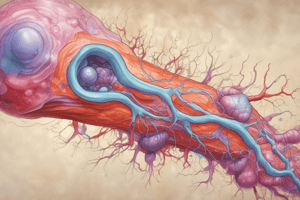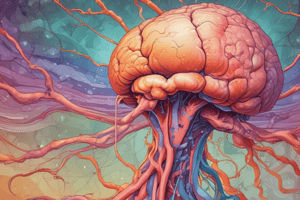Podcast
Questions and Answers
What is the primary cause of pheochromocytoma?
What is the primary cause of pheochromocytoma?
- A genetic mutation affecting kidney function.
- An autoimmune disorder targeting chromaffin cells.
- A bacterial infection in the adrenal cortex.
- A tumor in the adrenal medulla. (correct)
Which of the following is the most dangerous immediate effect of pheochromocytoma?
Which of the following is the most dangerous immediate effect of pheochromocytoma?
- Chronic hyperglycemia.
- Profound bradycardia.
- Progressive anemia.
- Severe hypertension. (correct)
What is the purpose of administering α-adrenergic receptor blockers before surgery for pheochromocytoma?
What is the purpose of administering α-adrenergic receptor blockers before surgery for pheochromocytoma?
- To directly shrink the size of the adrenal tumor.
- To stimulate insulin release and prevent hyperglycemia.
- To control blood pressure and prevent intraoperative hypertensive crisis. (correct)
- To reduce the risk of post-operative infection.
Which diagnostic test is considered the simplest and most reliable for detecting pheochromocytoma?
Which diagnostic test is considered the simplest and most reliable for detecting pheochromocytoma?
Which of the following actions should be avoided when assessing a patient suspected of having pheochromocytoma?
Which of the following actions should be avoided when assessing a patient suspected of having pheochromocytoma?
What is the likely outcome after surgical removal of an adrenal tumor causing pheochromocytoma?
What is the likely outcome after surgical removal of an adrenal tumor causing pheochromocytoma?
Why should β-adrenergic receptor blockers not be started before adequate α-adrenergic blockade in the treatment of pheochromocytoma?
Why should β-adrenergic receptor blockers not be started before adequate α-adrenergic blockade in the treatment of pheochromocytoma?
Which of the following medications is known to potentially induce an attack in a patient with pheochromocytoma?
Which of the following medications is known to potentially induce an attack in a patient with pheochromocytoma?
A patient with pheochromocytoma is started on α-adrenergic receptor blockers. What is an important nursing intervention related to this medication?
A patient with pheochromocytoma is started on α-adrenergic receptor blockers. What is an important nursing intervention related to this medication?
Which of the following conditions is commonly associated with inherited cases of pheochromocytoma?
Which of the following conditions is commonly associated with inherited cases of pheochromocytoma?
What medication is used to decrease catecholamine production when surgery is not an option for a patient diagnosed with pheochromocytoma?
What medication is used to decrease catecholamine production when surgery is not an option for a patient diagnosed with pheochromocytoma?
A patient presents with hypertension and symptoms of sympathoadrenal stimulation. What is the most appropriate nursing intervention?
A patient presents with hypertension and symptoms of sympathoadrenal stimulation. What is the most appropriate nursing intervention?
What is the classic triad of symptoms for pheochromocytoma?
What is the classic triad of symptoms for pheochromocytoma?
During a patient's 'attack' of pheochromocytoma symptoms, what is the priority nursing intervention?
During a patient's 'attack' of pheochromocytoma symptoms, what is the priority nursing intervention?
In addition to monitoring blood pressure, what other parameter should be monitored in patients with pheochromocytoma to assess for potential complications?
In addition to monitoring blood pressure, what other parameter should be monitored in patients with pheochromocytoma to assess for potential complications?
What aspects of care are important for patients with pheochromocytoma during their treatment?
What aspects of care are important for patients with pheochromocytoma during their treatment?
After adrenalectomy for pheochromocytoma, what should be emphasized to the patient regarding post-operative care?
After adrenalectomy for pheochromocytoma, what should be emphasized to the patient regarding post-operative care?
Which of the following vital sign changes should the nurse be prepared for during and after surgical removal of a pheochromocytoma?
Which of the following vital sign changes should the nurse be prepared for during and after surgical removal of a pheochromocytoma?
Why is the diagnosis of pheochromocytoma often missed?
Why is the diagnosis of pheochromocytoma often missed?
What is the most crucial aspect of post-operative care following surgical removal of a pheochromocytoma regarding blood pressure?
What is the most crucial aspect of post-operative care following surgical removal of a pheochromocytoma regarding blood pressure?
Flashcards
Pheochromocytoma
Pheochromocytoma
A rare tumor of the adrenal medulla causing excess catecholamines.
Catecholamines
Catecholamines
Hormones such as epinephrine and norepinephrine, increased in pheochromocytoma.
Severe Hypertension
Severe Hypertension
Dangerous high blood pressure occurring due to pheochromocytoma.
Episodic Symptoms
Episodic Symptoms
Signup and view all the flashcards
Triggers of Attacks
Triggers of Attacks
Signup and view all the flashcards
24-Hour Urine Test
24-Hour Urine Test
Signup and view all the flashcards
Alpha-Blockers
Alpha-Blockers
Signup and view all the flashcards
Beta-Blockers
Beta-Blockers
Signup and view all the flashcards
Surgical Removal
Surgical Removal
Signup and view all the flashcards
Orthostatic Hypotension
Orthostatic Hypotension
Signup and view all the flashcards
Metyrosine (Demser)
Metyrosine (Demser)
Signup and view all the flashcards
Classic triad of pheochromocytoma
Classic triad of pheochromocytoma
Signup and view all the flashcards
Hypertension referral
Hypertension referral
Signup and view all the flashcards
Blood pressure monitoring
Blood pressure monitoring
Signup and view all the flashcards
Surgical care for adrenalectomy
Surgical care for adrenalectomy
Signup and view all the flashcards
Assessing diabetes
Assessing diabetes
Signup and view all the flashcards
Emotional support
Emotional support
Signup and view all the flashcards
Monitoring glucose levels
Monitoring glucose levels
Signup and view all the flashcards
Post-surgery follow-up
Post-surgery follow-up
Signup and view all the flashcards
Study Notes
Pheochromocytoma Overview
- Rare tumor in the adrenal medulla, affecting chromaffin cells
- Causes excess catecholamine (epinephrine, norepinephrine) production
- Most immediate danger is severe hypertension
- Untreated, can lead to complications like encephalopathy, diabetes, cardiomyopathy, multiple organ failure, and death
- Most common in young to middle-aged adults
- Can be inherited in persons with MEN (multiple endocrine neoplasia) syndromes
- Characterized by episodic, severe hypertension
- Often accompanied by pounding headache, tachycardia, palpitations, profuse sweating, abdominal or chest pain
- Attacks triggered by trauma, pressure on tumor, stress, various drugs
Diagnostic Considerations
- Key diagnostic test: measurement of urinary fractionated metanephrines (catecholamine metabolites) and fractionated catecholamines and creatinine (typically 24-hour urine collection)
- Finding are elevated in at least 95% of cases
- Serum catecholamines also increased during hypertensive "attacks"
- Imaging methods (CT and MRI) used to detect tumors
- Crucial to avoid palpating the abdomen - this could trigger sudden catecholamine release causing severe hypertension
Management and Treatment
-
Primary treatment is surgical removal of the tumor
-
Pre-operative management crucial to control blood pressure (BP) and prevent intraoperative hypertensive crisis
-
Alpha-adrenergic blockers (e.g., doxazosin) are started 10–14 days before surgery to reduce blood pressure
-
Beta-blockers (e.g., propranolol) are used after adequate alpha-blockade to manage tachycardia and dysrhythmias; starting beta-blockers too early can lead to a hypertensive crisis
-
Post-operative considerations
- BP fluctuations are common and must be monitored closely
- If surgery is not an option, metyrosine (Demser) may be used to reduce catecholamine production
- Hypertension sometimes persists even after surgery (10-30% of cases)
- Follow-up appointments and regular BP monitoring is essential for long-term management.
Nursing Considerations and Case Finding
-
Nurses play a vital role in early detection
-
Patients with hypertension and symptoms of sympathoadrenal stimulation should be assessed by a healthcare professional
-
Look for classic triad symptoms (severe headache, tachycardia, profuse sweating)
-
Assess blood pressure frequently during attacks
-
Ensure patient comfort and provide necessary rest, nutrition, and emotional support
-
Monitor glucose levels to assess for potential diabetes
-
Post-operative care is similar to other adrenalectomy procedures
Studying That Suits You
Use AI to generate personalized quizzes and flashcards to suit your learning preferences.



